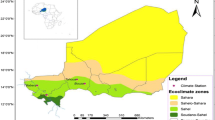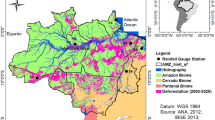Abstract
Meteorological drought is one of the inseparable climatic phenomena in sub-tropical countries such as Iran. In these areas, which encompass the vastest deserts of the world, the effects of precipitation scarcity on water resources manifest themselves promptly. This study employed the standardized precipitation index (SPI), as a meteorological drought assessment tool, over 3- and 12-month time scales during the years 1970 to 2014. We compared the accuracy of the neuro-fuzzy model (as a non-linear model) with time-series models for modeling of drought. Time-series analysis was conducted according to the Box–Jenkins method. ARIMA (3, 0, 4) and ARIMA (2, 0, 1) were selected as the best-fitting time-series models for modeling SPI at time scales of 3 and 12 months, respectively. The results indicated that the neuro-fuzzy model significantly outperforms the time-series models. The Nash–Sutcliffe efficiency (NSE) coefficients are equal to 0.12 and 0.60 respectively for SPI3 and SPI12 estimated by ARIMA model, while NSE coefficients for neuro-fuzzy model are equal to 0.52 and 0.80 respectively for SPI3 and SPI12 in validation period. Also, the violin plots demonstrated that the neuro-fuzzy model (unlike the ARIMA model) is well-suited to estimate the volatility of SPI values for wet and dry periods, which is a very important prerequisite for efficient water resources’ management.





Similar content being viewed by others
References
Abbasnejad A, Abbasnejad B (2013) Subsidence hazard zoning of Jiroft plain, Southeast Iran. IJERD 7:61–68
Agnew C, Warren A (1996) A framework for tackling drought and land degradation. J Arid Environ 33(3):309–320
Akaike H (1974) A look at the statistical model identification. IEEE Trans Autom Control 19:716–723
Akaike H (1978) Time series analysis and forecasting. The Box–Jenkins Approach. Butterworths, London
Awan JA, Bae DH (2016) Drought prediction over the East Asian monsoon region using the adaptive neuro-fuzzy inference system and the global sea surface temperature anomalies. Int J Climatol 36:4767–4777
Bazrafshan O, Salajegheh A, Bazrafshan J, Mahdavi M, Fatehi MA (2015) Hydrological drought forecasting using ARIMA models (case study: Karkheh Basin). Ecopersia 3(3):1099–1117
Belayneh A, Adamowski J, Khalil B, Ozga-Zielinski B (2014) Long-term SPI drought forecasting in the Awash River basin in Ethiopia using wavelet neural network and wavelet support vector regression models. J Hydrol 508:418–429
Beven K (2006) A manifesto for the equifinality thesis. J Hydrol 320:18–36
Bordi I, Sutera A (2007) Drought monitoring and forecasting at large scale. In: Methods and Tools for Drought Analysis and Management (pp. 3–27). Springer, Dordrecht
Box GEP, Jenkins GM (1976) Time series analysis: forecasting and control. Holden-Day, San Francisco
Choubin B, Malekian A (2017) Combined gamma and M-test-based ANN and ARIMA models for groundwater fluctuation forecasting in semiarid regions. Environ Earth Sci 76(15):538. https://doi.org/10.1007/s12665-017-6870-8
Choubin B, Khalighi-Sigaroodi S, Malekian A, Ahmad S, Attarod P (2014) Drought forecasting in a semi-arid watershed using climate signals: a neuro-fuzzy modeling approach. J Mt Sci 11(6):1593–1605. https://doi.org/10.1007/s11629-014-3020-6
Choubin B, Khalighi-Sigaroodi S, Malekian A, Kişi Ö (2016a) Multiple linear regression, multi-layer perceptron network and adaptive neuro-fuzzy inference system for forecasting precipitation based on large-scale climate signals. Hydrol Sci J 61(6):1001–1009. https://doi.org/10.1080/02626667.2014.966721
Choubin B, Malekian A, Golshan M (2016b) Application of several data-driven techniques to predict a standardized precipitation index. Atmósfera 29(2):121–128. https://doi.org/10.20937/ATM.2016.29.02.02
Choubin B, Malekian A, Samadi S, Khalighi-Sigaroodi S, Sajedi-Hosseini F (2017a) An ensemble forecast of semi-arid rainfall using large-scale climate predictors. Meteorol Appl. https://doi.org/10.1002/met.1635
Choubin B, Solaimani K, Habibnejad Roshan M, Malekian A (2017b) Watershed classification by remote sensing indices: a fuzzy c-means clustering approach. J Mt Sci 14. https://doi.org/10.1007/s11629-017-4357-4
Choubin B, Zehtabian G, Azareh A, Rafiei-Sardooi E, Sajedi-Hosseini F, Kişi Ö (2018) Precipitation forecasting using classification and regression trees (CART) model: a comparative study of different approaches. Environ Earth Sci 77(8):314. https://doi.org/10.1007/s1266
Dastorani MT, Afkhami H, Sharifidarani H et al (2010) Application of ANN and ANFIS models on drylandprecipitation prediction (case study: Yazd in Central Iran). J Appl Sci 10:2387–2394
Dickey DA, Fuller WA (1979) Estimators for autoregressive time series with a unit root. J Am Statist Assoc 74:427–431
Djerbouai S, Souag-Gamane D (2016) Drought forecasting using neural networks, wavelet neural networks, and stochastic models: case of the Algerois Basin in North Algeria. Water Resour Manag 30(7): 2445–2464
El-Shafie A, Jaafer O, Akrami SA (2011) Adaptive neuro-fuzzy inference system based model for rainfall forecasting in Klang River, Malaysia. IJPS 6(12):2875–2888
Erian W (2012) Drought Vulnerability in the Arab Region Special Case Study: Syria (Geneva: United Nations International Strategy for Disaster Risk Reduction, 2010). Shahrzad Mohtadi, Climate Change and the Syrian Uprising, Bulletin of the Atomic Scientists, 5
Farokhnia A, Morid S, Byun HR (2011) Application of global SST and SLP data for drought forecasting on Tehran plain using data mining and ANFIS techniques. Theor Appl Climatol 104(1–2):71–81
Gibbs WJ (1975) Drought: its definition, delineation and effects. In: Drought: lectures presented at the26th session ofthe WMO executive committee, special environmental report no.5, WMO, Geneva, pp 3–39
Gocić M, Motamedi S, Shamshirband S, Petković D, Hashim R (2015) Potential of adaptive neuro-fuzzy inference system for evaluation of drought indices. Stoch Env Res Risk A 29(8):1993–2002
Han P, Wang PX, Zhang SY, Zhu DH (2010) Drought forecasting based on the remote sensing data using ARIMA models. Math Comput Model 51:1398–1403
Hintze JL, Nelson RD (1998) Violin plots: a box plot-density trace synergism. Am Stat 52(2):181–184
Hosseini-Moghari SM, Araghinejad S (2015) Monthly and seasonal drought forecasting using statistical neural networks. Environ Earth Sci 74:397–412
Jang JSR (1993) ANFIS: adaptive-network-based fuzzy inference system. IEEE Trans Syst Man Cybern 23(3):665–685
Karavitis C, Vasilakou C, Tsesmelis D, Oikonomou P, Skondras N, Stamatakos D, Fassouli V, Alexandris S (2015) Short-term drought forecasting combining stochastic and geo-statistical approaches. E W 49: 43–63
Ljung GM, Box GE (1978) On a measure of lack of fit in time series models. Biometrika 65(2):297–303
Makridakis S, Wheelwright SC, Hyndman R (2003) Forecasting methods and applications. Wiley (ASIA) Pvt Ltd., Singapore 923 pp
McKee TB, Doesken NJ, Kleist J (1993) The relationship of drought frequency and duration to time scales. In proceeding of the 8th Conference on Applied Climatology, 17–22 January 1993, Anaheim: California
Mishra AK, Desai VR (2005) Drought forecasting using stochastic models. Stoch Env Res Risk A 19:326–339
Moriasi DN, Arnold JG, Van Liew MW, Binger RL, Harmel RD, Veith T (2007) Model evaluation guidelines for systematic quantification of accuracy in watershed simulations. Trans ASABE 50(3):885–900
Mossad A, Alazba AA (2015) Drought forecasting using stochastic models in a hyper-arid climate. Atmosphere 6:410–430
Nash JE, Sutcliffe JV (1970) River flow forecasting through conceptual models: part 1. A discussion of principles. J Hydrol 10(3):282–290
Odingo RS (1992) Implementation of the plan of action to combat desertification (PACD) 1978–1991. Desert Cont Bul 21:6–14
Pourseyadi A, Kashkuli H (2012) Studying of groundwater conditions in Jiroft Basin with Modflow. JISE 35(2):51–63
Rezaeianzadeh M, Stein A, Cox JP (2016) Drought forecasting using Markov chain model and artificial neural networks. Water Resour Manag 30(7):2245–2259
Sanikhani H, Kisi O (2012) River flow estimation and forecasting by using two different adaptive neuro-fuzzy approaches. Water Resour Manag 26(6):1715–1729. https://doi.org/10.1007/s11269-012-9982-7
Shirmohammadi B, Moradi H, Moosavi V, Semiromi MT, Zeinali A (2013) Forecasting of meteorological drought using wavelet-ANFIS hybrid model for different time steps (case study: southeastern part of east Azerbaijan province, Iran). Nat Hazards 69:389–402
Sigaroodi SK, Chen Q, Ebrahimi S, Nazari A, Choobin B (2014) Long-term precipitation forecast for drought relief using atmospheric circulation factors: a study on the Maharloo Basin in Iran. Hydrol Earth Syst Sci 18(5):1995–2006. https://doi.org/10.5194/hess-18-1995-2014
Stahl K, Kohn I, Blauhut V, Urquijo J, De Stefano L, Acácio V, Dias S, Stagge JH, Tallaksen LM, Kampragou E, Van Loon AF (2016) Impacts of European drought events: insights from an international database of text-based reports. Nat Hazards Earth Syst Sci 16(3):801–819
Stringer LC, Dyer JC, Reed MS, Dougill AJ, Twyman C, Mkwambisi D (2009) Adaptations to climate change, drought and desertification: local insights to enhance policy in southern Africa. Environ Sci Pol 12(7):748–765
Wilhite DA (2005) Drought and water crises: science, technology, and management issues. Press, CRC
Acknowledgements
This study was partially funded by University of Tehran.
Author information
Authors and Affiliations
Corresponding author
Rights and permissions
About this article
Cite this article
Rafiei-Sardooi, E., Mohseni-Saravi, M., Barkhori, S. et al. Drought modeling: a comparative study between time series and neuro-fuzzy approaches. Arab J Geosci 11, 487 (2018). https://doi.org/10.1007/s12517-018-3835-5
Received:
Accepted:
Published:
DOI: https://doi.org/10.1007/s12517-018-3835-5




